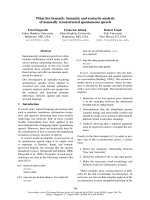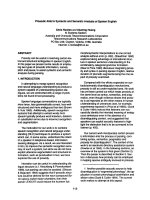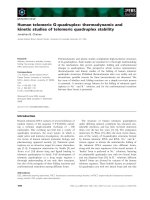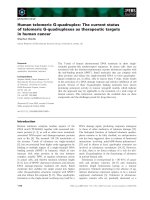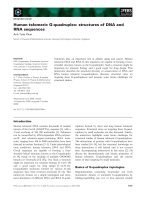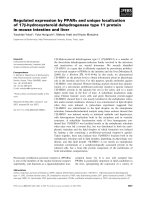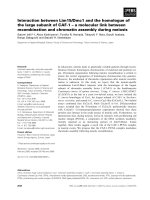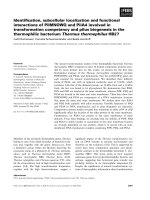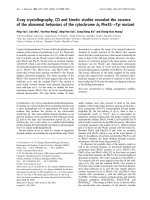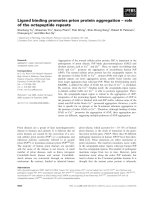Báo cáo khoa học: Human telomeric G-quadruplex: thermodynamic and kinetic studies of telomeric quadruplex stability potx
Bạn đang xem bản rút gọn của tài liệu. Xem và tải ngay bản đầy đủ của tài liệu tại đây (276.44 KB, 9 trang )
MINIREVIEW
Human telomeric G-quadruplex: thermodynamic and
kinetic studies of telomeric quadruplex stability
Jonathan B. Chaires
James Graham Brown Cancer Center, University of Louisville, Kentucky, KY, USA
Introduction
Human telomeric DNA consists of several kilobases of
tandem repeats of the sequence 5¢-TTAGGG, includ-
ing a terminal single-stranded overhang of $ 200
nucleotides. This overhang can fold into a variety of
quadruplex structures, the exact nature of which is
under active and intensive investigation. An authorita-
tive review of human telomere molecular biology and
pharmacology appeared recently [1]. Telomeric quad-
ruplexes are an attractive target for cancer chemother-
apy [2–8]. Companion minireviews by Neidle [9] and
Arora et al. [10] discuss drug and ligand binding to
telomeric quadruplexes in detail. Full development of
telomeric quadruplexes as a drug target requires a
thorough understanding of not only their structures,
but also of the energetics of their folding reactions and
conformational transitions among different forms.
The structure of human telomeric quadruplexes
under differing solution conditions has attracted con-
siderable attention, and has been reviewed numerous
times over the last few years [11–16]. The companion
minireview by Phan [17] offers the most recent discus-
sion of the variety of G-quadruplex structures formed
by human telomeric DNA and RNA. Na
+
and K
+
cations appear to dictate the unimolecular folding of
the telomeric DNA sequence into different forms,
along with the exact sequences of the strand termini. A
‘basket’ form is preferred in Na
+
solutions, featuring
an antiparallel quadruplex core with two lateral loops
and one diagonal loop [18]. In K
+
solutions, different
‘hybrid’ forms are favored by variants of the human
telomere sequence. These hybrids feature an antiparal-
lel quadruplex core with two lateral loops and one side
Keywords
allostery; calorimetry; enthalpy; entropy;
folding; free energy; kinetics; quadruplex
DNA; spectroscopy; thermodynamics
Correspondence
J. B. Chaires, James Graham Brown
Cancer Center, University of Louisville,
529 S. Jackson Street, Louisville, KY 40202,
USA
Fax: +1 502 852 1153
Tel: +1 502 852 1172
E-mail:
(Received 25 June 2009, revised
26 August 2009, accepted 17 September
2009)
doi:10.1111/j.1742-4658.2009.07462.x
Thermodynamic and kinetic studies complement high-resolution structures
of G-quadruplexes. Such studies are essential for a thorough understanding
of the mechanisms that govern quadruplex folding and conformational
changes in quadruplexes. This perspective article reviews representative
thermodynamic and kinetic studies of the folding of human telomeric
quadruplex structures. Published thermodynamic data vary widely and are
inconsistent; possible reasons for these inconsistencies are discussed. The
key issue of whether such folding reactions are a simple two-state process
is examined. A tentative energy balance for the folding of telomeric quad-
ruplexes in Na
+
and K
+
solution, and for the conformational transition
between these forms is presented.
Abbreviations
DSC, differential scanning calorimetry; FRET, fluorescence resonance energy transfer; smFRET, single-molecule fluorescence resonance
energy transfer; SVD, singular value decompostion.
1098 FEBS Journal 277 (2010) 1098–1106 ª 2009 The Author Journal compilation ª 2009 FEBS
(‘chain reversal’) loop [16,19,20]. The position of the
side loop varies in these hybrid forms. In crystals, a
unique ‘propeller’ form is favored that features a
parallel-stranded quadruplex core and three side loops
[21]. Biophysical studies [22] have shown that the pro-
peller form was not the major form in solution, a find-
ing subsequently validated by high-resolution NMR
studies [16,19,20,23]. The energy of folding these vari-
ous forms and the energetic cost of converting one
form to another is of fundamental importance for
understanding telomere biology and the interactions of
small molecules and proteins with telomeric DNA. The
folding and unfolding of quadruplexes may be of pro-
found physiological importance because quadruplex
structures may form transiently in telomeres at specific
times in the cell cycle as part of a regulatory mecha-
nism [1,8].
The energetic and kinetic aspects of G-quadruplexes
have received comparatively less attention. Kumar &
Maiti [24] provided a thermodynamic overview of nat-
urally occurring intramolecular quadruplexes, focusing
primarily on quadruplexes that might form within gene
promoter sequences. Lane and colleagues [25] provided
a critical survey of the stability and kinetics of quadru-
plex structures, and posed some key unsolved prob-
lems that need to be addressed. An algorithm for
predicting quadruplex stability based on the rather
sparse set of existing thermodynamic data was recently
described [26]. This predictive algorithm promises to
be an important new tool which recognizes that the
biological significance of quadruplex structures is
tightly linked to their thermodynamic stability.
Methods for studying quadruplex
folding and unfolding
The folding and unfolding of G-quadruplexes can be
conveniently monitored using spectroscopic methods.
Changes in absorbance or CD as a function of salt
concentration or changes in temperature provide a sig-
nal for the determination of the fraction of folded or
unfolded DNA strand, allowing for the calculation of
the equilibrium distribution of conformational forms.
Standard methods using UV absorbance at a single
wavelength to monitor the thermal denaturation of
nucleic acid structures have been fully described,
including the mathematical formalism needed for the
quantitative analysis of melting curves [27–30]. Mergny
et al. [31] noted the desirability and utility of monitor-
ing quadruplex formation by recording reversible
absorbance changes at 295 nm, a wavelength that is
selectively sensitive to disruption of the quadruplex
stack. A particularly valuable protocol has recently
been published that describes the practical details of
UV melting studies of G-quadruplexes, with an thor-
ough discussion of common problems and pitfalls [32].
The use of fluorescence to monitor the thermal dena-
turation of quadruplex-forming oligonucleotides
labeled with a fluorescence resonance energy transfer
(FRET) pair has been described [33,34]. A decided
advantage of fluorescent methods is their high sensitiv-
ity, providing the ability to use small volumes and low
concentrations of quadruplexes. One possible dis-
advantage of FRET methods is that the added labels
may alter the stability of the structure. CD is particu-
larly sensitive to quadruplex structures, and can be
used to conveniently monitor quadruplex formation
[34], although expensive instrumentation is needed.
General formalism for the quantitative analysis of
thermal denaturation reactions using CD data has
recently appeared [35]. All of these spectroscopic meth-
ods yield thermodynamic data only indirectly, and
transitions curves must be fit to specific models to
obtain enthalpy, entropy and free-energy values.
Almost inevitably, folding or unfolding reactions are
assumed, for convenience, to be two-state processes,
with negligible concentrations of any intermediate spe-
cies. Calorimetry (differential scanning calorimetry,
DSC, and isothermal titration calorimetry) can be used
to monitor quadruplex folding and unfolding reac-
tions, with the significant advantage that enthalpy
changes can be monitored directly and data obtained
in a model-free fashion [36,37]. Disadvantages of calo-
rimetry are the high concentrations and amounts of
material necessary, and the need for expensive instru-
mentation.
Energetics of unfolding human
telomeric quadruplexes
Representative thermodynamic values for the unfold-
ing of human telomere quadruplexes taken from the
literature are shown in Table 1. Data were gathered
for similar sequences and for studies performed using
similar solution conditions. The results are both
disturbing and discouraging. There is an unacceptably
wide range in the values reported from different labo-
ratories. Reported T
m
values range from 56 to 63.7 °C
in 100 mm Na
+
and from 63 to 81.8 ° C in 100 mm
K
+
. Enthalpy values range from 38 to 72.7 kcalÆmol
)1
in Na
+
and from 49 to 77.5 kcalÆmol
)1
in K
+
. The
origin of these discrepancies is not at all clear.
Although slight sequence variations might be offered
as one source of the differing values, inspection of
Table 1 shows that even identical sequences in solu-
tions with the same cation concentration yield different
J. B. Chaires Telomeric quadruplex stability
FEBS Journal 277 (2010) 1098–1106 ª 2009 The Author Journal compilation ª 2009 FEBS 1099
results in different laboratories. It is impossible to say
why this is. Different annealing procedures may con-
tribute, or the addition of fluorescent labels that alter
quadruplex stability may be another culprit.
There are several potential pitfalls in reliably obtain-
ing thermodynamic parameters from spectroscopic
transition curves. The first is the difficulty in establish-
ing reliable pre- and post-transition baselines. Any
transformation of the primary data or any attempt to
directly analyze the primary data by curve fitting must
include choices concerning these baselines. Slopes in
baseline regions may arise from intrinsic physical phe-
nomena, such as the intrinsic temperature dependence
of fluorescence or from absorbance changes resulting
from solvent expansion. More insidiously, however,
such slopes could arise from additional reactions that
complicate study of the denaturation transition. These
may involve thermally driven processes like helix–helix
transition or single-strand base unstacking that precede
the actual helix melting transition. Such transitions
may have small enthalpy values, leading to broad, fea-
tureless melting transitions. Attempts to ‘correct’ the
sloping baselines that arise from such complications
would lead to oversimplification of the true reaction
mechanism, and to a loss of information. Even without
such complications, establishing proper baselines pre-
sents practical problems. There are worrisome reports
documenting that the lengths of the pre- and post-
transition baselines selected and used in data analysis
directly affect the values of the thermodynamic param-
eters extracted from the data [38,39]. Investigators of
G-quadruplex denaturation should be fully aware of
these difficulties and should describe in detail their
procedures for establishing baselines for analysis.
Another pitfall is the common assumption that
denaturation reactions are simple two-state processes
and simply pass from a folded ‘native’ state to an
unfolded denatured state without any intermediates.
The two-state assumption must be justified by some
experimental test. A classical test, first utilized for pro-
tein denaturation studies, is to obtain denaturation
curves using two (or more) different physical methods
[40]. If transition curves obtained using the multiple
methods are exactly superimposable, that is consistent
with a two-state mechanism. More recent tests utilizing
multiple wavelength data have appeared. A dual-wave-
length parametric test for a two-state denaturation
transition monitored by spectroscopy has been
described [41]. In this test, data obtained at two differ-
ent wavelengths are plotted against one another. For a
two-state transition, such a plot should be strictly
linear. Deviations from strict linear behavior signal
that the denaturation process is not two-state, and
likely has intermediate states that are significantly pop-
ulated. Singular value decomposition provides an addi-
tional test of the two-state assumption [42–44]. With
modern diode array spectrophotometers, it is easy to
collect entire spectra as a function of temperature,
instead of single wavelength data. A set of spectra as a
function of temperature defines a 3D surface that is
easily converted to a matrix. Singular value decompo-
sition (SVD) of the matrix rigorously enumerates the
number of significant spectral species required to
account for the spectral changes without reference to
any specific model. For a two-state transition, there
should be only two significant spectral species, corre-
sponding to the folded and unfolded forms. Any num-
ber of species greater than two indicates a violation of
the two-state assumption, and signals the presence of
intermediates. SVD (or a similar multivariate analysis
method) has been used to characterize the denatur-
ation of G-quadruplex or other four-stranded struc-
Table 1. Energetics of human telomere quadruplex unfolding. DH, DS and DG are for the unfolding direction.
Sequence (5¢-to3¢) Cation (m
M) T
m
(°C)
DH
(kcalÆmol
)1
)
DS
(calÆmol
)1
ÆK
)1
)
DG
(310 K)
(kcalÆmol
)1
) Ref.
(TTAGGG)
4
Na
+
(70) 49 38.0 119 1.1 74
K
+
(70) 63 49.0 147 3.4
AGGG(TTAGGG)
3
Na
+
(100) 56 54.0 163 3.5 31
K
+
(100) 63 57.0 169 4.6
GGG(TTAGGG)
3
Na
+
(100) 58 51 155 3.0 31
K
+
(100) 65 60.5 179 5.0
GGG(TTAGGG)
3
Na
+
(100) 63.7 72.7 192 13.2 75
K
+
(100) 69.3 77.5 202 14.8
TGGG(TTAGGG)
3
a
Na
+
(100) 62.8 51.4 153 3.9 76
K
+
(100) 81.8 66.2 186.5 8.4
AGGG(TTAGGG)
3
b
K
+
(100) 66.1 34.4 101.4 3.0 77
a
Determined using fluorescence resonance energy transfer with labeled strand.
b
Determined using differential scanning calorimetry.
Telomeric quadruplex stability J. B. Chaires
1100 FEBS Journal 277 (2010) 1098–1106 ª 2009 The Author Journal compilation ª 2009 FEBS
tures [45–47]. SVD analysis is not easily explained in
limited space, so the literature cited should be con-
sulted for details of using the procedure.
A final pitfall is the neglect of heat capacity changes
(DC
p
) that may accompany quadruplex denaturation.
Heat capacity changes are correlated with the exposure
of hydrophobic surface areas [48,49] as well as increas-
ing fluctuations among microstates associated with the
less compact forms [50], so it would be surprising
indeed if the unfolding of quadruplex structures, with
concomitant exposures of the bases, was not accompa-
nied by a nonzero DC
p
value. Unfortunately, it is enor-
mously difficult to reliably fit transition curves to
obtain derivative values of the primary thermodynamic
parameters [51]. Small heat capacity changes could
manifest themselves as contributors to sloping base-
lines, and might easily be ‘corrected out’ at the expense
of systematic errors in enthalpy values. Even when a
van’t Hoff plot of ln K versus T
)1
is constructed by
transformation of the primary transition curve prob-
lems remain. Nonzero DC
p
values should lead to cur-
vature in the van’t Hoff plot. However, Monte Carlo
simulations of van’t Hoff plots showed that for ‘small’
(< |200| calÆmol
)1
ÆK
)1
) DC
p
values, which are typical
of values observed for nucleic acid unfolding, no cur-
vature could in fact be observed within the typical
error of experimental data, but that slopes were sys-
tematically biased away from true enthalpy values [52].
All of these pitfalls may contribute to the discrepant
results shown in Table 1. Additional thermodynamic
studies are needed to resolve the discrepancies and to
obtain a coherent picture of the thermodynamic profile
for quadruplex formation. Thermodynamic studies of
quadruplex folding are perhaps best done using calori-
metric methods in which enthalpy values may be deter-
mined as directly as possible. Spectrophotometric
methods can certainly be used as well, provided proper
attention is paid to baseline determinations and to
fitting the primary data to appropriate unfolding
models that include intermediate states, if necessary.
Multiple states in quadruplex
denaturation
CD and DSC have been used in a recent study to mea-
sure the thermodynamics of human telomere quadru-
plex unfolding in K
+
solution [45]. SVD analysis of
CD spectra collected as a function of temperature
revealed the presence of an intermediate species along
the melting pathway. Quadruplex denaturation is thus
not a simple two-state process. The shapes of thermo-
grams obtained by DSC also indicated multiple spe-
cies. Multiple intermediate species were also found in
Na
+
solution for denaturation of the human telomere
quadruplex (J. Li & J. B. Chaires, unpublished data).
A significant advantage of DSC is that model-free
thermodynamic information can be obtained for com-
plex reactions from the experimental thermograms
without fitting to any particular model. The thermo-
gram yields the overall enthalpy directly as the integral
of the thermogram:
DH ¼
Z
C
p
dT ð1Þ
The overall entropy may be calculated as:
DS ¼
Z
C
p
T
dT ð2Þ
The free energy change may then be calculated from
the Gibbs equation:
DG ¼ DH À TDS ð3Þ
Figure 1 shows representative thermograms for the
denaturation of human telomere quadruplexes in Na
+
and K
+
solutions, along with the overall free energy
for the denaturation process.
Multiple states in single molecule
experiments
A number of studies that use single-molecule fluores-
cence resonance energy transfer (smFRET) methods to
examine the stability and dynamics of human telomere
quadruplexes have appeared [53–57]. Collectively, these
studies reveal that in both Na
+
and K
+
solution mul-
tiple conformational forms coexist. Temperature and
changes in the cation concentration both perturb the
equilibria between these species. A dynamic switching
model between unfolded and folded quadruplex
conformational forms was proposed that included six
distinct states [54]. Single base mutations within the
G-tetrad stack were subsequently found to dramati-
cally alter the distribution and dynamics of quadruplex
forms [53].
Telomeric G-quadruplex structures with strategic
BrG substitutions were studied using smFRET [55].
The observed FRET distributions included at least five
components, the relative population of which
depended strongly on the exact position of the BrG
substitution. The results were integrated into a coher-
ent model that incorporated the most recent
high-resolution structural information. The model
includes a proposed triple-stranded core conformation
along the folding pathway to hybrid quadruplex struc-
tures, and equilibrium between hybrid and ‘chair’
quadruplex forms.
J. B. Chaires Telomeric quadruplex stability
FEBS Journal 277 (2010) 1098–1106 ª 2009 The Author Journal compilation ª 2009 FEBS 1101
Simple two-state models for quadruplex denatur-
ation discussed above (Table 1) are inconsistent with
the complexity revealed by smFRET methods. The
presence of intermediates along the denaturation path-
way inferred from SVD analysis [45] is at least quali-
tatively consistent with the multiple species observed
in smFRET studies. One caveat in comparing
smFRET results with ensemble solution studies needs
to be considered. All smFRET studies to date have
used constructs in which single-stranded telomeric
DNA sequences are tethered to a segment of duplex
DNA. The biophysical properties of a similar con-
struct were described earlier [46]. The attachment of
the duplex can alter the stability of the folded quad-
ruplex segment relative to folding of an unadorned
single-stranded sequence. The concepts of ‘telestabili-
ty’ [58,59] and allostery in DNA [60] can account for
differences in the stability of tethered and free
sequences.
Kinetics of human telomere quadruplex
folding
Formation of tetramolecular quadruplex structures is
fourth order with respect to strand association and is
exceedingly slow [61]. By contrast, unimolecular fold-
ing of the human telomeric sequence is expected to
be first order, and could be rapid. Stopped-flow
kinetic studies showed that folding of the human
telomere quadruplex is indeed fast [62]. In that
study, cation-induced folding into quadruplex struc-
tures for three model human teleomeric oligonucleo-
tides, d[AGGG(TTAGGG)
3
], d[TTGGG(TTAGG
G)
3
A] and d[TTGGG(TTAGGG)
3
], was characterized
by equilibrium titrations with KCl and NaCl and by
multi-wavelength stopped-flow kinetics. Cation bind-
ing was cooperative with Hill coefficients of 1.5–2.2
in K
+
and 2.4–2.9 in Na
+
, with half-saturation con-
centrations of 0.5–1 mm for K
+
and 4–13 mm for
Na
+
depending on the oligonucleotide sequence.
Oligonucleotide folding in 50 mm KCl at 25 °C con-
sisted of single exponential processes with relaxation
times (s) of 20–60 ms depending on the sequence. By
contrast, folding in 100 mm NaCl consisted of three
exponentials with s values of 40–85 ms, 250–950 ms
and 1.5–10.5 s. The folding rate constants
approached limiting values with increasing cation
concentration; in addition, the rates of folding
decreased with increasing temperature over the range
15–45 °C. Taken together, these results suggest that
folding of G-rich oligonucleotides into quadruplex
structures proceeds via kinetically significant interme-
diates. These intermediates may consist of antiparallel
double hairpins in rapid equilibrium with less
ordered structures. The hairpins may subsequently
form nascent G-quartets stabilized by hydrogen
bonding and cation binding followed by relatively
slow strand rearrangements to form the final com-
pletely folded topologies. Fewer kinetic intermediates
were evident with K
+
than Na
+
, suggesting a sim-
pler folding pathway in K
+
solutions. These studies
show directly and unambiguously that more than
two states must be considered in the folding and
unfolding of telomeric quadruplex structures.
A
B
Fig. 1. Thermodynamics of denaturation of human telomere quadru-
plex structures in buffered Na
+
(black) or K
+
(red) solutions. The total
cation concentration was 200 m
M, pH 7.0. (A) Results from DSC
experiments. Integration of the thermograms shown yields direct
estimates of the total enthalpy required for denaturation (Eqn 1). (B)
Total free-energy cost of denaturing quadruplex structures as a
function of temperature. Total free energy was estimated from the
thermograms in (A) using Eqn (3).
Telomeric quadruplex stability J. B. Chaires
1102 FEBS Journal 277 (2010) 1098–1106 ª 2009 The Author Journal compilation ª 2009 FEBS
Quadruplex conformational transitions
Cations and a variety of small molecule ligands have
been shown to facilitate quadruplex folding or to facil-
itate the transition from one quadruplex conforma-
tional form to another [63–72]. In order to fully
understand such allosteric effects, the energetics of the
underlying conformational transitions in quadruplex
structures must be determined. The thermodynamics
and kinetics of the transition of the human telomere
quadruplex between the Na
+
basket form and the K
+
hybrid form was recently described [73]. CD and DSC
were used to determine the energetics of the conforma-
tional switch of the human telomere quadruplex
formed by the sequence d[AGGG(TTAGGG)
3
]
between the Na
+
basket form and the K
+
hybrid
form. The energy barrier separating the two conforma-
tions was found to be modest, only 1.4–2.4 kcalÆmol
)1
.
The kinetics of exchange of bound K
+
for Na
+
cations and the concomitant conformational switch
was assessed by measuring time-dependent changes in
the CD spectrum accompanying the cation exchange
reaction. The time course of these changes was found
to consist of three distinct kinetic processes: a rapid
phase that was complete in < 5 ms followed by two
slower phases with relaxation times of 40–50 and 600–
800 s at 25 °C and pH 7.0. The kinetics were inter-
preted in terms of a model in which the bound Na
+
cations are rapidly replaced by K
+
followed by rela-
tively slow structural rearrangements to generate the
final K
+
-bound product(s). CD studies showed that
addition of the porphyrin TmPyP4 promoted conver-
sion of the basket to the hybrid form. The kinetics
of the TmPyP4-induced conformational change were
the same as those observed for the cation exchange
reaction.
Summary and conclusions
All recent evidence points to the fact that the folding
and unfolding of human telomeric quadruplex struc-
tures are not simple two-state processes, but rather
proceed along a pathway with multiple intermediate
states. Once formed, quadruplex structures can inter-
convert between forms. Surprisingly, small energy
barriers separate the basket and hybrid conformations
Na
+
Form
K
+
Form
–4.3 kcal·mol
–1
(50 ms; 10 s)
1.4–2.4 kcal·mol
–1
(5 ms;40–50 s; 600–800 s)
–6.7 kcal·mol
–1
(7–10 ms; 20–60 ms)
Fig. 2. Free-energy cycle for telomeric
quadruplex folding and interconversion
between the basket and hybrid forms. Total
free-energy estimates for each step in the
cycle are shown in bold. Relaxation times
observed for each path are shown in italics.
No intermediate states are shown along
each pathway, only the initial and final
states. Guanine bases are shown in green,
adenines in red and thymines in blue.
J. B. Chaires Telomeric quadruplex stability
FEBS Journal 277 (2010) 1098–1106 ª 2009 The Author Journal compilation ª 2009 FEBS 1103
of the human telomeric quadruplex. Similarly, unfold-
ing of quadruplex forms requires only modest expendi-
tures of energy. That fact may be of biological
significance, since quadruplex unfolding may be tightly
coupled to protein binding that stabilizes the single-
stranded overhang at specific times during the cell
cycle to facilitate replication.
Figure 2 portrays a tentative free-energy cycle for
human telomere quadruplex folding and for the transi-
tion from the basket and hybrid forms. Best available
estimates for the overall free energies and for the relax-
ation times for each transition are shown (possible
intermediate steps are not shown). The magnitudes of
the free energies show that an intricate and subtle
balance of forces drive the transition between folded
forms and the unfolded state.
Acknowledgements
This study was supported by NIH grant GM077422. I
thank Drs Luigi Petraccone and Robert Gray for their
help in the preparation of Fig. 2 and for helpful
discussions. I thank Dr Nichola Garbett for helpful
comments on the manuscript.
References
1 De Cian A, Lacroix L, Douarre C, Temime-Smaali N,
Trentesaux C, Riou JF & Mergny JL (2008) Targeting
telomeres and telomerase. Biochimie 90, 131–155.
2 Huppert JL (2007) Four-stranded DNA: cancer, gene
regulation and drug development. Philos Transact A
Math Phys Eng Sci 365, 2969–2984.
3 Huppert JL (2008) Four-stranded nucleic acids: struc-
ture, function and targeting of G-quadruplexes. Chem
Soc Rev 37, 1375–1384.
4 Wong HM, Payet L & Huppert JL (2009) Function and
targeting of G-quadruplexes. Curr Opin Mol Ther 11,
146–155.
5 Hurley LH (2002) DNA and its associated processes
as targets for cancer therapy. Nat Rev Cancer 2, 188–
200.
6 Mergny JL & Helene C (1998) G-quadruplex DNA: a
target for drug design. Nat Med 4, 1366–1367.
7 Neidle S & Parkinson G (2002) Telomere maintenance
as a target for anticancer drug discovery. Nat Rev Drug
Discov 1, 383–393.
8 Oganesian L & Bryan TM (2007) Physiological rele-
vance of telomeric G-quadruplex formation: a potential
drug target. BioEssays 29, 155–165.
9 Neidle S (2009) Human telomeric G-quadruplex: The
current status of telomeric G-quadruplexes as
therapeutic targets in human cancer. FEBS J 277,
1118–1125.
10 Arora A, Kumar N, Agarwal T & Mait S (2009)
Human telomeric G-quadruplex: targetting with small
molecules. FEBS J 277, 1345.
11 Neidle S & Parkinson GN (2003) The structure of
telomeric DNA. Curr Opin Struct Biol 13, 275–283.
12 Neidle S (2009) The structures of quadruplex nucleic
acids and their drug complexes. Curr Opin Struct Biol
19, 239–250.
13 Burge S, Parkinson GN, Hazel P, Todd AK & Neidle S
(2006) Quadruplex DNA: sequence, topology and struc-
ture. Nucleic Acids Res 34, 5402–5415.
14 Patel DJ, Phan AT & Kuryavyi V (2007) Human telo-
mere, oncogenic promoter and 5¢-UTR G-quadruplexes:
diverse higher order DNA and RNA targets for cancer
therapeutics. Nucleic Acids Res 35, 7429–7455.
15 Dai J, Carver M & Yang D (2008) Polymorphism of
human telomeric quadruplex structures. Biochimie 90,
1172–1183.
16 Xu Y, Noguchi Y & Sugiyama H (2006) The new mod-
els of the human telomere d[AGGG(TTAGGG)
3
]in
K
+
solution. Bioorg Med Chem 14, 5584–5591.
17 Phan AT (2009) Human telomeric G-quadruplex: struc-
tures of DNA and RNA sequences. FEBS J 277, 1107–
1117.
18 Wang Y & Patel DJ (1993) Solution structure of the
human telomeric repeat d[AG
3
(T
2
AG
3
)
3
] G-tetraplex.
Structure 1, 263–282.
19 Ambrus A, Chen D, Dai J, Bialis T, Jones RA & Yang
D (2006) Human telomeric sequence forms a hybrid-
type intramolecular G-quadruplex structure with mixed
parallel ⁄ antiparallel strands in potassium solution.
Nucleic Acids Res 34, 2723–2735.
20 Phan AT, Kuryavyi V, Luu KN & Patel DJ (2007)
Structure of two intramolecular G-quadruplexes formed
by natural human telomere sequences in K
+
solution.
Nucleic Acids Res 35, 6517–6525.
21 Parkinson GN, Lee MP & Neidle S (2002) Crystal
structure of parallel quadruplexes from human telo-
meric DNA. Nature 417, 876–880.
22 Li J, Correia JJ, Wang L, Trent JO & Chaires JB
(2005) Not so crystal clear: the structure of the human
telomere G-quadruplex in solution differs from that
present in a crystal. Nucleic Acids Res 33, 4649–
4659.
23 Matsugami A, Xu Y, Noguchi Y, Sugiyama H &
Katahira M (2007) Structure of a human telomeric
DNA sequence stabilized by 8-bromoguanosine substi-
tutions, as determined by NMR in a K
+
solution.
FEBS J 274, 3545–3556.
24 Kumar N & Maiti S (2008) A thermodynamic overview
of naturally occurring intramolecular DNA quadruplex-
es. Nucleic Acids Res 36, 5610–5622.
25 Lane AN, Chaires JB, Gray RD & Trent JO (2008)
Stability and kinetics of G-quadruplex structures.
Nucleic Acids Res 36, 5482–5515.
Telomeric quadruplex stability J. B. Chaires
1104 FEBS Journal 277 (2010) 1098–1106 ª 2009 The Author Journal compilation ª 2009 FEBS
26 Stegle O, Payet L, Mergny JL, MacKay DJ & Leon JH
(2009) Predicting and understanding the stability of
G-quadruplexes. Bioinformatics 25, i374–i382.
27 Marky LA & Breslauer KJ (1987) Calculating thermo-
dynamic data for transitions of any molecularity from
equilibrium melting curves. Biopolymers 26, 1601–1620.
28 Plum GE (2000) Optical methods. In Current Protocols
in Nucleic Acid Chemistry (Bergstrom DE, ed.), pp.
7.3.1–7.3.17. Wiley, New York, NY.
29 Puglisi JD & Tinoco I Jr (1989) Absorbance melting
curves of RNA. Methods Enzymol 180, 304–325.
30 Mergny JL & Lacroix L (2003) Analysis of thermal
melting curves. Oligonucleotides 13, 515–537.
31 Mergny JL, Phan AT & Lacroix L (1998) Following
G-quartet formation by UV-spectroscopy. FEBS Lett
435, 74–78.
32 Mergny JL & Lacroix L (2009) UV melting of G-quad-
ruplexes. In Current Protocols in Nucleic Acid Chemistry
(Beaucage SL, Herdewijn P & Matsuda A, eds), pp.
17.1.1–17.1.15. Wiley, New York, NY.
33 De Cian A, Guittat L, Kaiser M, Sacca B, Amrane S,
Bourdoncle A, Alberti P, Teulade-Fichou MP, Lacroix L
& Mergny JL (2007) Fluorescence-based melting assays
for studying quadruplex ligands. Methods 42, 183–195.
34 Rachwal PA & Fox KR (2007) Quadruplex melting.
Methods 43, 291–301.
35 Greenfield NJ (2007) Using circular dichroism collected
as a function of temperature to determine the thermo-
dynamics of protein unfolding and binding interactions.
Nat Protoc 1, 2527–2535.
36 Haq I, Chowdhry BZ & Jenkins TC (2001) Calorimetric
techniques in the study of high-order DNA–drug inter-
actions. Methods Enzymol 340, 109–149.
37 Majhi PR, Qi J, Tang CF & Shafer RH (2008) Heat
capacity changes associated with guanine quadruplex
formation: an isothermal titration calorimetry study.
Biopolymers 89, 302–309.
38 Allen DL & Pielak GJ (1998) Baseline length and
automated fitting of denaturation data. Protein Sci 7,
1262–1263.
39 Cooper A (1999) Thermodynamic analysis of biomolec-
ular interactions. Curr Opin Chem Biol 3, 557–563.
40 Lumry R & Biltonen R (1966) Validity of the
‘two-state’ hypothesis for conformational transitions of
proteins. Biopolymers 4, 917–944.
41 Wallimann P, Kennedy RJ, Miller JS, Shalongo W &
Kemp DS (2003) Dual wavelength parametric test of
two-state models for circular dichroism spectra of
helical polypeptides: anomalous dichroic properties of
alanine-rich peptides. J Am Chem Soc 125, 1203–1220.
42 DeSa RJ & Matheson IB (2004) A practical approach
to interpretation of singular value decomposition
results. Methods Enzymol 384, 1–8.
43 Haq I, Chowdhry BZ & Chaires JB (1997) Singular
value decomposition of 3-D DNA melting curves
reveals complexity in the melting process. Eur Biophys J
26, 419–426.
44 Hendler RW & Shrager RI (1994) Deconvolutions
based on singular value decomposition and the pseudo-
inverse: a guide for beginners. J Biochem Biophys Meth-
ods 28, 1–33.
45 Antonacci C, Chaires JB & Sheardy RD (2007) Bio-
physical characterization of the human telomeric
(TTAGGG)
4
repeat in a potassium solution. Biochemis-
try 46, 4654–4660.
46 Ren J, Qu X, Trent JO & Chaires JB (2002) Tiny telo-
mere DNA. Nucleic Acids Res 30, 2307–2315.
47 Jaumot J, Escaja N, Gargallo R, Gonzalez C, Pedroso
E & Tauler R (2002) Multivariate curve resolution: a
powerful tool for the analysis of conformational transi-
tions in nucleic acids. Nucleic Acids Res 30, e92.
48 Prabhu NV & Sharp KA (2005) Heat capacity in pro-
teins. Annu Rev Phys Chem 56, 521–548.
49 Spolar RS & Record MT Jr (1994) Coupling of local
folding to site-specific binding of proteins to DNA.
Science 263, 777–784.
50 Lane AN & Jenkins TC (2000) Thermodynamics of
nucleic acids and their interactions with ligands. Q Rev
Biophys 33, 255–306.
51 Prehoda KE, Mooberry ES & Markley JL (1998) Pres-
sure denaturation of proteins: evaluation of compress-
ibility effects. Biochemistry 37, 5785–5790.
52 Chaires JB (1997) Possible origin of differences between
van’t Hoff and calorimetric enthalpy estimates. Biophys
Chem 64, 15–23.
53 Lee JY & Kim DS (2009) Dramatic effect of single-base
mutation on the conformational dynamics of human
telomeric G-quadruplex. Nucleic Acids Res 37, 3625–
3634.
54 Lee JY, Okumus B, Kim DS & Ha T (2005) Extreme
conformational diversity in human telomeric DNA.
Proc Natl Acad Sci USA 102, 18938–18943.
55 Okamoto K, Sannohe Y, Mashimo T, Sugiyama H &
Terazima M (2008) G-quadruplex structures of human
telomere DNA examined by single molecule FRET
and BrG-substitution. Bioorg Med Chem 16, 6873–
6879.
56 Shirude PS & Balasubramanian S (2008) Single mole-
cule conformational analysis of DNA G-quadruplexes.
Biochimie 90, 1197–1206.
57 Ying L, Green JJ, Li H, Klenerman D & Balasubrama-
nian S (2003) Studies on the structure and dynamics of
the human telomeric G quadruplex by single-molecule
fluorescence resonance energy transfer. Proc Natl Acad
Sci USA 100, 14629–14634.
58 Burd JF, Larson JE & Wells RD (1975) Further studies
on telestability in DNA. The synthesis and characteriza-
tion of the duplex block polymers d(C20A10)–
d(T10G20) and d(C20A15)–d(T15G20). J Biol Chem
250, 6002–6007.
J. B. Chaires Telomeric quadruplex stability
FEBS Journal 277 (2010) 1098–1106 ª 2009 The Author Journal compilation ª 2009 FEBS 1105
59 Burd JF, Wartell RM, Dodgson JB & Wells RD (1975)
Transmission of stability (telestability) in deoxyribonu-
cleic acid. Physical and enzymatic studies on the duplex
block polymer d(C15A15)–d(T15G15). J Biol Chem
250, 5109–5113.
60 Schurr JM, Delrow JJ, Fujimoto BS & Benight AS
(1997) The question of long-range allosteric transitions
in DNA. Biopolymers 44, 283–308.
61 Mergny JL, De Cian A, Ghelab A, Sacca B & Lacroix
L (2005) Kinetics of tetramolecular quadruplexes.
Nucleic Acids Res 33, 81–94.
62 Gray RD & Chaires JB (2008) Kinetics and mechanism
of K
+
- and Na
+
-induced folding of models of human
telomeric DNA into G-quadruplex structures. Nucleic
Acids Res 36, 4191–4203.
63 Arthanari H & Bolton PH (1999) Porphyrins can cata-
lyze the interconversion of DNA quadruplex structural
types. Anticancer Drug Des 14, 317–326.
64 Engelhart AE, Plavec J, Persil O & Hud NV (2008)
Metal ion interactions with G-quadruplex structures. In
Nucleic Acid–Metal Ion Interactions (Hud NV, ed), pp.
114–149. Royal Society of Chemistry, Cambridge.
65 Han H, Cliff CL & Hurley LH (1999) Accelerated
assembly of G-quadruplex structures by a small mole-
cule. Biochemistry 38, 6981–6986.
66 Hud NV & Plavec J (2006) The role of cations in deter-
mining quadruplex structure and stability. In Quadruplex
Nucleic Acids (Neidle S & Balasubramanian S, eds),
pp. 100–130. Royal Society of Chemistry, Cambridge.
67 Nakatani K, Hagihara S, Sando S, Sakamoto S,
Yamaguchi K, Maesawa C & Saito I (2003) Induc-
tion of a remarkable conformational change in a
human telomeric sequence by the binding of naph-
thyridine dimer: inhibition of the elongation of a
telomeric repeat by telomerase. J Am Chem Soc 125,
662–666.
68 Rezler EM, Seenisamy J, Bashyam S, Kim M-Y, White
E, Wilson WD & Hurley LH (2005) Telomestatin and
diseleno sapphyrin bind selectively to two different
forms of the human telomeric G-quadruplex structure.
J Am Chem Soc 127, 9439–9447.
69 Rodriguez R, Pantos GD, Goncalves DP, Sanders JK &
Balasubramanian S (2007) Ligand-driven G-quadruplex
conformational switching by using an unusual mode of
interaction. Angew Chem Int Ed Engl 46, 5405–5407.
70 Sen D & Gilbert W (1990) A sodium–potassium switch
in the formation of four-stranded G4-DNA. Nature
344, 410–414.
71 Yu H, Wang X, Fu M, Ren J & Qu X (2008) Chiral
metallo-supramolecular complexes selectively recognize
human telomeric G-quadruplex DNA. Nucleic Acids
Res 36, 5695–5703.
72 Zhang HJ, Wang XF, Wang P, Ai XC & Zhang JP
(2008) Spectroscopic study on the binding of a cationic
porphyrin to DNA G-quadruplex under different K
+
concentrations. Photochem Photobiol Sci 7, 948–955.
73 Gray RD, Li J & Chaires JB (2009) Energetics and
kinetics of a conformational switch in G-quadruplex
DNA. J Phys Chem B 113, 2676–2683.
74 Balagurumoorthy P & Brahmachari SK (1994) Struc-
ture and stability of human telomeric sequence. J Biol
Chem 269, 21858–21869.
75 Li W, Wu P, Ohmichi T & Sugimoto N (2002) Charac-
terization and thermodynamic properties of quadru-
plex ⁄ duplex competition. FEBS Lett 526, 77–81.
76 Risitano A & Fox KR (2003) Stability of intramolecu-
lar DNA quadruplexes: comparison with DNA
duplexes. Biochemistry 42, 6507–6513.
77 Olsen CM, Gmeiner WH & Marky LA (2006) Unfold-
ing of G-quadruplexes: energetic, and ion and water
contributions of G-quartet stacking. J Phys Chem B
110, 6962–6969.
Telomeric quadruplex stability J. B. Chaires
1106 FEBS Journal 277 (2010) 1098–1106 ª 2009 The Author Journal compilation ª 2009 FEBS
